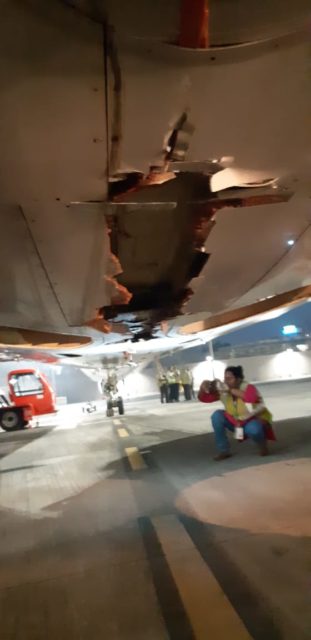Hitting the Wall
In the early hours of the morning, an Air India aircraft struck the airport perimeter wall at Tiruchirappalli International Airport in Tamil Nadu, India.
Tiruchirappalli International Airport, commonly referred to as ‘Trichy’, has a 2,480-meter asphalt runway (8,136 feet) which is planned to be extended. The runway is 9/27 and the wall in question is on the west perimeter of the airport, so no prizes for guessing the direction of the take-off.
I normally would wait for the investigation to have time to release at least a preliminary report but these photographs are too unbelievable to share.
Air India Express flight 611, a Boeing 737-800, departed Tiruchirappalli for a scheduled flight to Dubai with 130 passengers and six crew on board.
Airport staff reported that the Boeing 737 might have come in contact with the airport perimeter wall. ATC contacted the flight crew to warn them that they may have come in contact with the airport perimeter wall. The captain responded that the aircraft systems were operating normally and that they were not aware of any damage.
Here’s a photograph of the west side airport perimeter wall, taken while the aircraft was still in the air:
Tiruchy, Tamil Nadu. Air India Express flight to Dubai hit the boundary wall of the Tiruchy International Airport during its take off from Tiruchy. No casualties reported so https://t.co/sbL0BxNyOf Ashok Kumar pic.twitter.com/5jn7LI0XJ4
— ASHOK KUMAR (@ashokkumar_TNIE) October 12, 2018
And here’s a second photograph, taken when the Tamil Nadu minister visited the site:

The wheel of the aircraft struck the top of the wall and also took out an ILS antenna, based on this NOTAM (Notice to Airmen):
A2770/18 NOTAMR A2769/18 Q) VOMF/QISXX/IV/NBO/A/000/999/ A) VOTR B) 1810120023 C) 1901121000 EST E) ILS RWY 27 NOT AVBL DUE LLZ ANTENNA BROKEN BY ACFT HIT
The aircraft diverted to Mumbai as a precautionary measure where it landed at 5:35 local time, four hours after departure. The aircraft landed safely and taxied to the parking stand for inspection. And sure enough, there they found a piece of fence in the wheel and damage to the underside of the aircraft.
Here’s a photograph of the fuselage, taken once they were safely on the ground at Mumbai:
And Twitter user Tarun Shukla has posted more photographs here:
Air India Trichy pics coming in. Severe Boeing 737 damage pic.twitter.com/SJVGLiEQvx
— Tarun Shukla (@shukla_tarun) October 12, 2018
Air India reports that the two pilots have been derostered pending investigation, while a fresh aircraft and relief crew were dispatched to Mumbai to take the passengers to their intended destination of Dubai. Air India has set up an internal inquiry, stating so far only that it is not yet clear whether this was a technical snag or pilot error.
Directorate General of Civil Aviation (DGCA) has ordered a high-level probe.
Media references:
- https://timesofindia.indiatimes.com/city/trichy/air-india-express-plane-hits-trichy-airport-compound-wall-lands-safely-in-mumbai/articleshow/66173131.cms
- https://www.moneycontrol.com/news/business/air-india-express-flight-hits-wall-at-tiruchi-airport-all-passengers-safe-3038451.html
- https://www.flightglobal.com/news/articles/air-india-express-737-suffers-belly-gash-after-strik-452626/









Another few cm lower and it would have been game over? Amazing pics.
Apart from “OH DEAR that was close !” (Yes, I can only agree with the previous comment), there is not much here that gives us, casual readers, a handle.
If the aircraft was within weight and balance tolerances for the runway AND the prevailing weather conditions, AND assuming that they would have done their preparations including carefully consulting the RTOW (Regulated Take-Off Weight) or TL tables for the correct type and version of aircraft, AND assuming that they had done all calculations diligently AND had the power set correctly AND assuming that the engines were delivering the correct power AND they made the correct call-outs during the take-off, then the cause may, just may NOT have been with the pilots.
But I already used a lot of “AND” and might as well have added some “IF” for good measure.
Snow and ice accretion on the wings would not have been a factor.
But this case may not be as clear-cut as it seems at first reading.
Apart from the casual reaction of the captain when told that he had struck the fence, there is nothing in this article that allows for the finger to be pointed at the crew.
Informative and funny, thanks… I hope we get to hear the true cause of the accident.
The BBC coverage of this incident
https://www.bbc.com/news/world-asia-india-45833239
mentions another recent case that was certainly pilot error — the pilot forgot to turn on the cabin air-pressure system. This is a major operation with experienced crew, not the sort of on-the-job training that we have read about in the last two postings, so I’m wondering what requirements there are for commercial pilots in India to be periodically tested or evaluated (“checkride”?) to make sure they at least do all the steps (cf Rudy’s list) when they’re being watched.
Wikipedia reports the 737-800 carrying 162-189 passengers, so there would have been empty seats (lowering the weight), but we’ll have to wait for details to know how much fuel it was carrying. But even in the hot weather of southern India, I’d be surprised at a 737 not meeting the rules for takeoff on a runway that long at almost sea-level.
Chip,
Performance calculations for an aircraft involved in commercial operations can be very protracted and difficult .
But they are not a ‘hit and miss’ affair.
Factors have to be taken into account like runway length, obstacles, elevation, and on top of that air temperature, pressure, wind etc.
The actual data of the aircraft have to be factored in, with actual fuel and payload to obtain all parameters: speeds and power setting.
The end result should cover not only the distance of the take-off roll but also engine failure and requirements in the event of a return, including covering missed approach single-engine and a few other factors.
It should also alert pilots in the event of an overload, e.g. too much fuel or too high a payload. I have had to make a difficult decision once or twice to offload passengers because prevailing weather conditions at the destination made me determine to add fuel. Sometimes passengers are willing to accept a booking on a later flight voluntarily – with an upgrade to business class as sweetener.
The RTOW tables that should be carried in the aircraft have most of these elements pre-calculated, for a given aircraft on a given runway.
This simplifies the whole process of calculations. Fixed data are the aircraft basics and runway and elevation The variables such as actual weight, air temperature and wind are entered.and that should result in V-speeds, power setting, flap- and slat setting and the correct pitch angle for take-off. This all sounds complex, but in fact the computers have already done the difficult job for the crew.
So: If the crew applies what can be derived simply and quickly from the tables and observe the weight limitations then the aircraft, when all are applied correctly, should normally meet the criteria and therefore lift off without any problem. EVEN with an engine failure at V-1.
So there is just a chance – however slim – that if the crew indeed did observe and apply all criteria, somehow the data were incorrect.
I agree, this is not very likely. It sounds more as if the aircraft had been overloaded. “Overloaded” not necessarily meaning beyond the aircraft’s structural capacity to carry the fuel- and payload, but in the sense that under the given conditions the available runway and obstacle clearance were insufficient to lift off safely within the available distance. Mistakenly using TL (RTOW) tables for the wrong runway of course can have the same result.
In my days we carried those tables in printed form. I can imagine that perhaps to-day these data may be stored in the on-board computer systems. And I can also imagine that it could be possible to bring up the data for the wrong airport and / or runway
This is quite a bizarre incident. The crew did not notice the impact. Damage to the fuselage but the undercarriage still seemed to work. Odd. I would have expected the undercarriage to have been very badly damaged.
The gear may have been retracted…but the B737 has those big underslung engines. How did THEY avoid damage?
Considering the height of the wall as seen on the photos the call “positive rate – gear up” would not even have been made yet.
So the gear handle would still have been in the “down” position, the retraction process would not have started yet..
The nosewheel hit the wall, insofar as I can make out.
Don’t forget: When parked, the engines are hanging from the wing and the nacelles are well clear of the ground.
Once airborne, the wigs will have been producing lift, the wings would have been bent slightly upwards so the clearance would in fact have increased. Look at the wings bending, next time you are in an aircraft.
On top of that, the undercarriage would have extended further, lower since the weight of the aircraft would no longer be on it.
So there would have been a considerable clearance between the bottom of the wheels (nosewheel) and the engines.
Wheels hitting wall, engines well clear ! No doubt whatsoever.
From what happened it seems clear that the wall collapsed relatively easily, the nose gear was not damaged but debris (stones) flying caused substantial damage to the underside.
I still cannot make out what caused this incident, though.
Nearly certainly “pilot error”, but what error?
Did the crew misread the performance calculation tables?
Were they using the wrong tables?
Did they enter the tables using the wrong data?
Did they miscalculate the required power setting?
Did they use flexi-power and if so, were the circumstances (wind, temperature, payload) allowing flexi power?
Was there an error in the weight? Don’t forget: calculations are made with the assumption that one engine will fail. With both engines running there is normally a surplus of power that will carry an aircraft aloft, even if the total weight is exceeding the maximum for the circumstances.
Or did the airline fail to provide take-off performance (RTOW) tables?
Nearly inconceivable, but perhaps there are operators that cut corners in this way.
If so, were those tables in fact valid for the type and specific variant of that particular aircraft?
Rudy — I get that serious calculations are needed; I’ve been subjected to the numbers having to be reworked at least twice (once when the plane had to add a fueling stop, and once when the crew begged for deplaning volunteers because the plane was already fully fueled). But I’d be surprised if they were overloaded-for-the-circumstances when starting with ~70% of passenger capacity. Your guesses about bad tables from a sloppy operator (or even the wrong airport’s tables — this airport has only one runway, so they couldn’t have made that error) seem possible, as does a random misuse of the tables by the crew.
wrt your response to Roger: would the engines, even as raised by the wings at takeoff speed, be further off the ground than the nosewheel at a normal takeoff angle? I’ve been in a flight that took off at a very low angle, presumably because it could — in front of it there was no land with occupants to complain about the noise, just 3000 miles of ocean; does the nosewheel impact suggest that the PF didn’t rotate far enough for the circumstances?
My thinking was that that rounded gap in the wall seemed to conform to the shape and size of the fuselage, an idea reinforced by the damage to the belly aft of the plastron. Never even considered the possibility of a nose gear strike. But wouldn’t individual bricks hitting the underside cause random dents and gouges rather than that lengthy tear depicted? Seems to indicate sustained contact. I will certainly like to read the reports after all is done… Speculation is a fun exercise in applied knowledge (when done properly) but it is just academic.